On the Road is a weekday feature spotlighting reader photo submissions.
From the exotic to the familiar, whether you’re traveling or in your own backyard, we would love to see the world through your eyes.
MollyS
In October, I went back to Paris to visit my daughter and son-in-law. While working on her Ph.D. in French literature, my daughter spent several summers and full semesters in Paris. She met and married a terrific young Frenchman and they now live in the 17th arrondissement, north of the world-famous attractions along the Seine.
For this visit, she and I decided to spend the weekend in Lyon, France’s second-largest metro area, some 245 miles southeast of Paris. Lyon was established by the Romans in 43 BC, where the Rhône and Saône rivers meet. The city became the capital of the Gauls during the Roman Empire. Today Lyon is a UNESCO World Heritage site and the gastronomic capital of France. The city was once a world center for the production of silk, and is also the home of the Lumière brothers, inventors of the cinemascope, the grandparent of the modern film camera.
We spent most of our two days in Vieux Lyon, the city’s oldest section, located in the Fourvière district, across the Saôme. At the time we were there, 1 US dollar was about equal to 1 euro, which made shopping, eating, etc., a very good deal. Saturday’s walk took us to the ancient Gothic Cathédrale Saint-Jean-Baptiste de Lyon.
On Sunday, after an amazing outdoor brunch, we went In search of the huge church high on the hill, visible from almost everywhere in Lyon. Getting up there was another story.
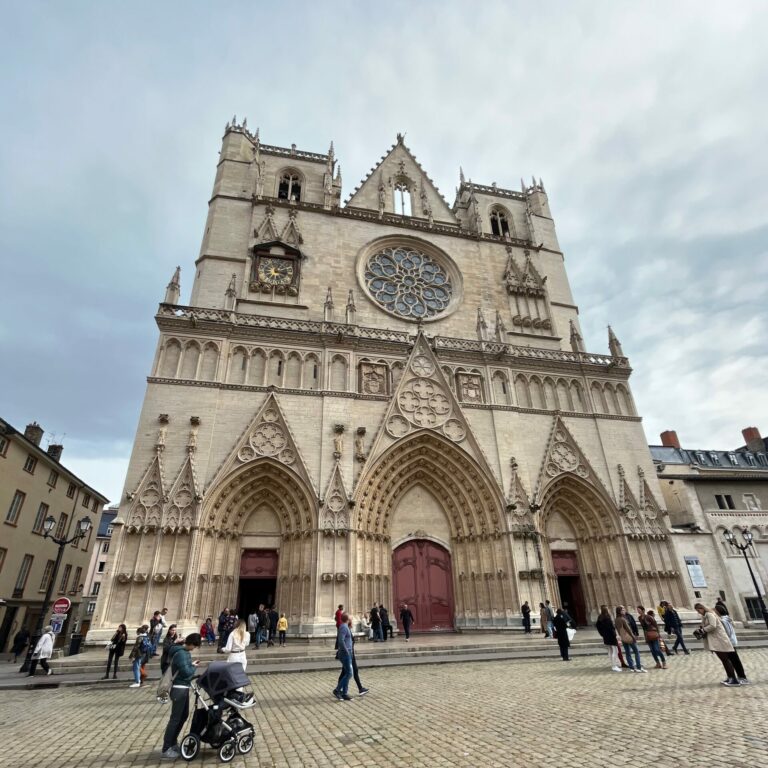
The Cathédrale Saint-Jean-Baptiste de Lyon, on the place Saint-Jean, is dedicated to Saint John the Baptist, and is the seat of the Archbishop of Lyon. Construction began in 1180, on the ruins of a 6th-century church, and was finished in 1476. A combination of Romanesque and Gothic architecture, the cathedral is on the UNESCO World Heritage List. For anyone who remembers Pope John XXIII (1958-63), the coronation of his name predecessor, John XXII (one of the Avignon popes), was held in the cathedral, in 1316. Check out this website for all sorts of historical information on the cathedral as well as many photos of the interior — https://www.abelard.org/france/cathedrals6_lyon.php#stained_glass
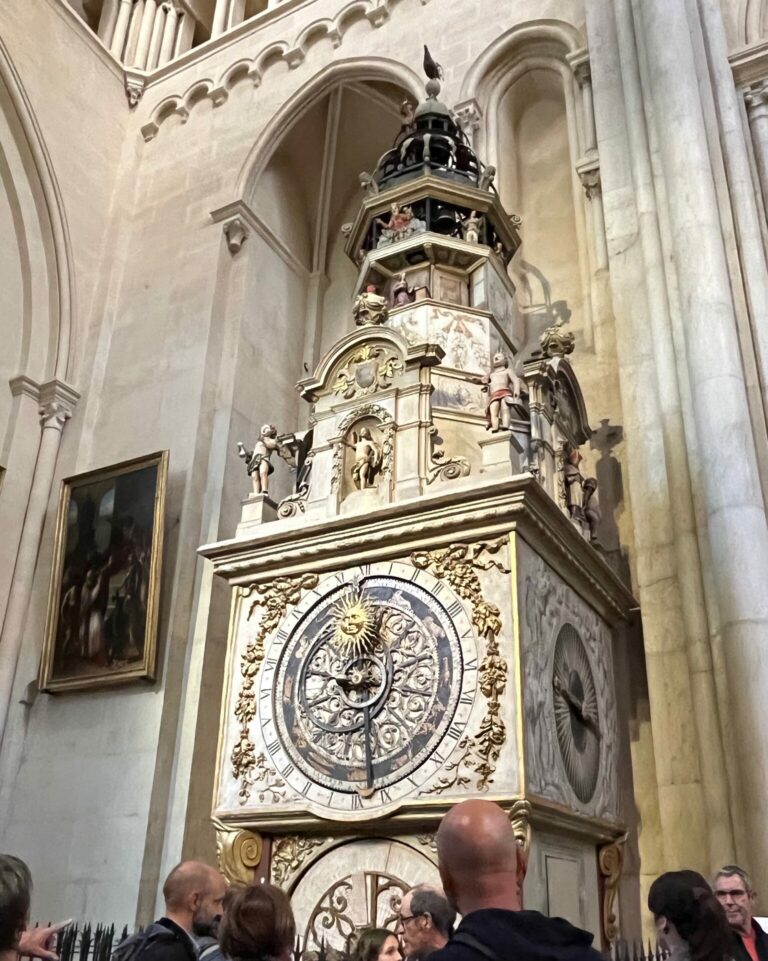
The Lyon astronomical clock. This amazing, almost 30-foot-tall clock, is located just inside the cathedral. One of the oldest clocks in Europe, it features an astrolabe showing the date and position of the moon, sun, earth, and stars, although here, the sun goes around the earth. Documents place the first astronomical clock in the cathedral from 1383 until it was destroyed in 1562. The clock was rebuilt in 1661, then had all its royal insignia removed during the French Revolution. In 1954, another restoration reset the clock’s perpetual calendar of 66 years. It remained accurate until 2019. Unfortunately, the amazing movements of the various saints and angels no longer happen as the clock itself has not worked for the last several years.
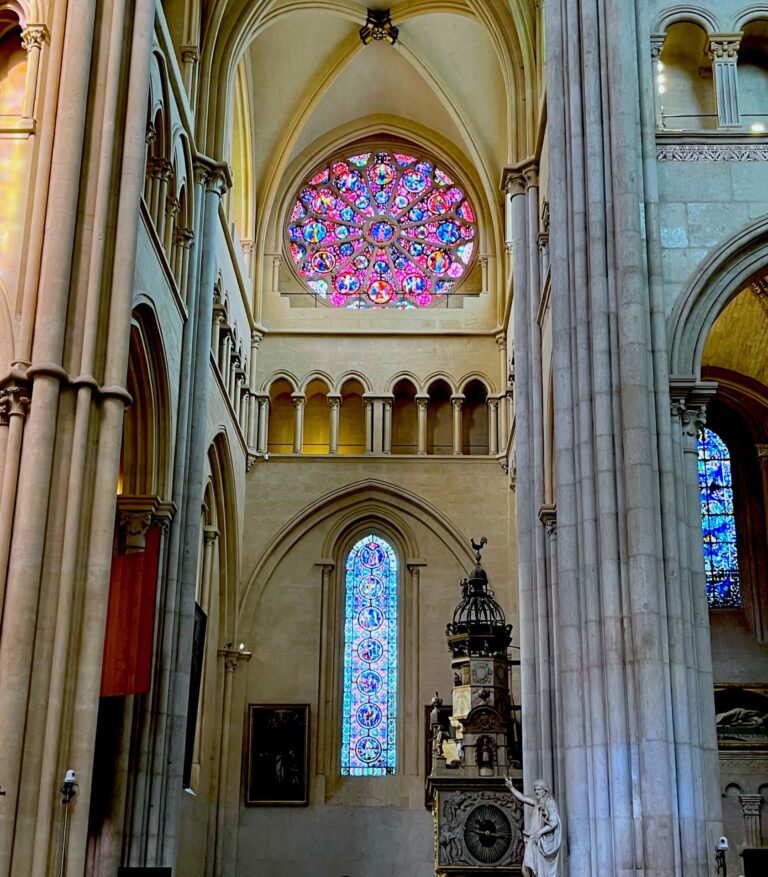
The northern transept rose window is from the eighteenth century. The two concentric rows of twelve medallions portray the good and bad angels. The good angels kneel in adoration before Jesus; the bad angels are falling, head first, into nothingness. You can see the astronomical clock below the window.
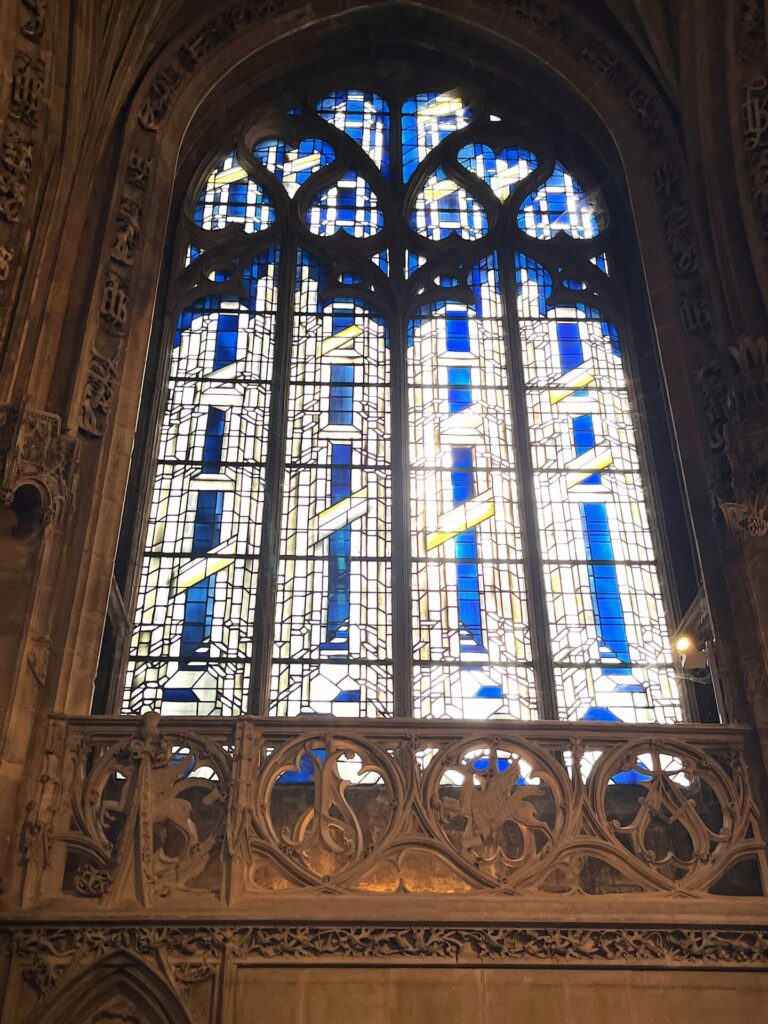
One of the cathedral’s contemporary stained glass examples, this window is among those commissioned to replace windows destroyed during the German occupation in World War II.
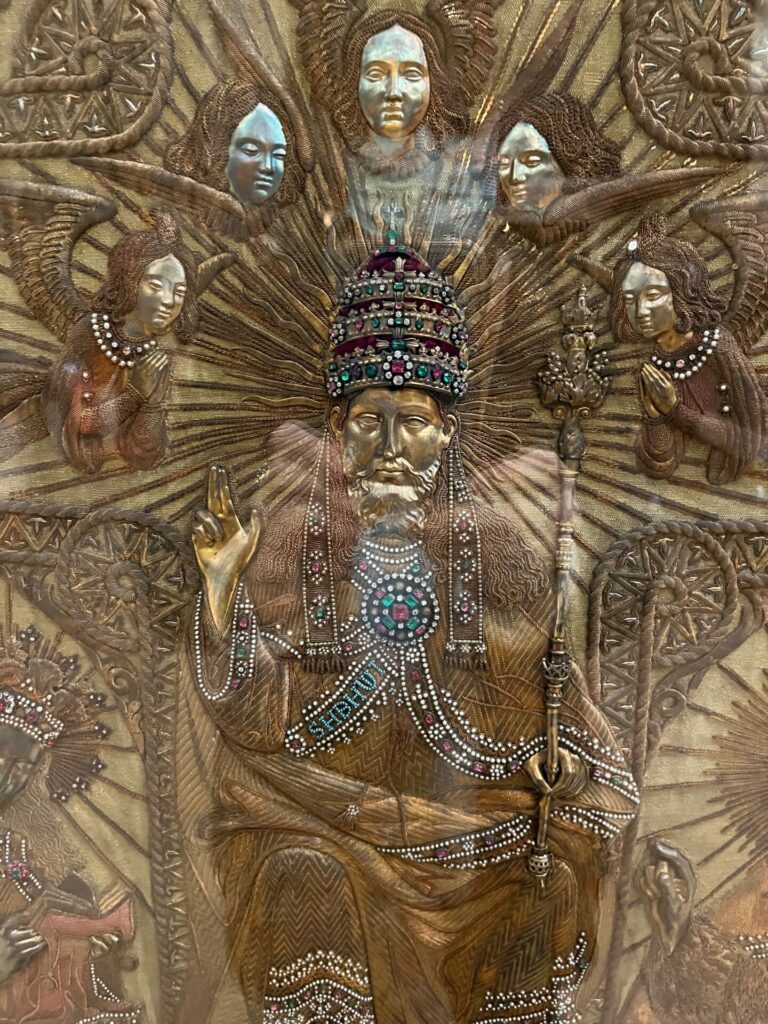
Detail from an elaborately beaded and embroidered vestment, which would have been worn by the priest during a daily Mass.
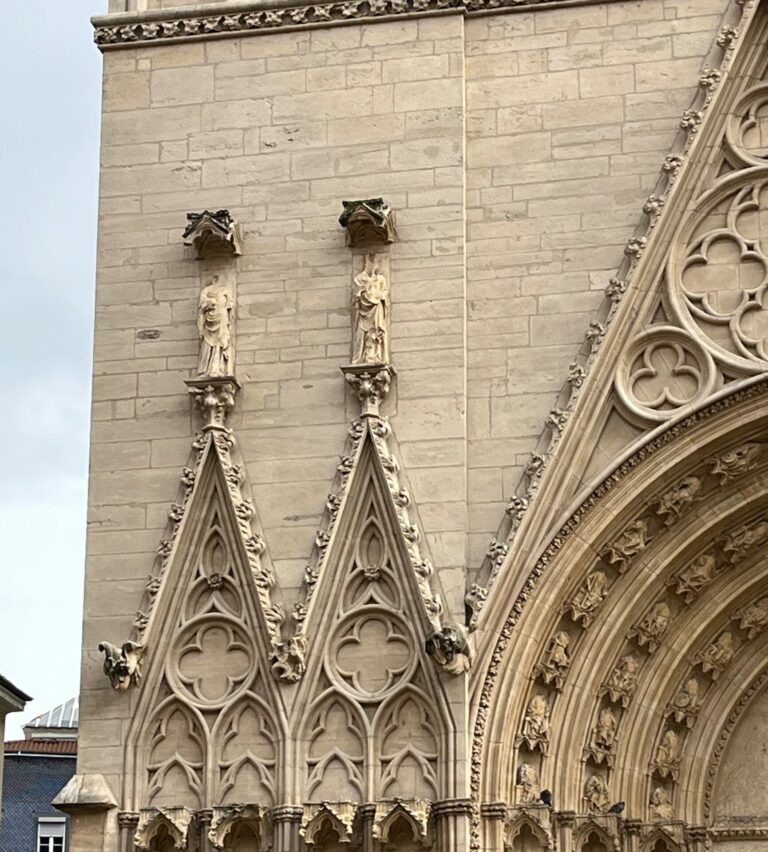
Like the religious statues on many French churches and public buildings, the Cathedral’s saints and holy people lost their heads during the French Revolution. In 1977, 21 of 28 decapitated heads chopped off their statues on the west façade of Notre Dame in Paris were discovered. The heads belong to the ancient Kings of Judah, not the French kings, as the Revolutionary mob thought. The Judah heads had been stashed inside a wall of an old mansion in Paris’s Opera district and are now on display in the musee de Cluny.
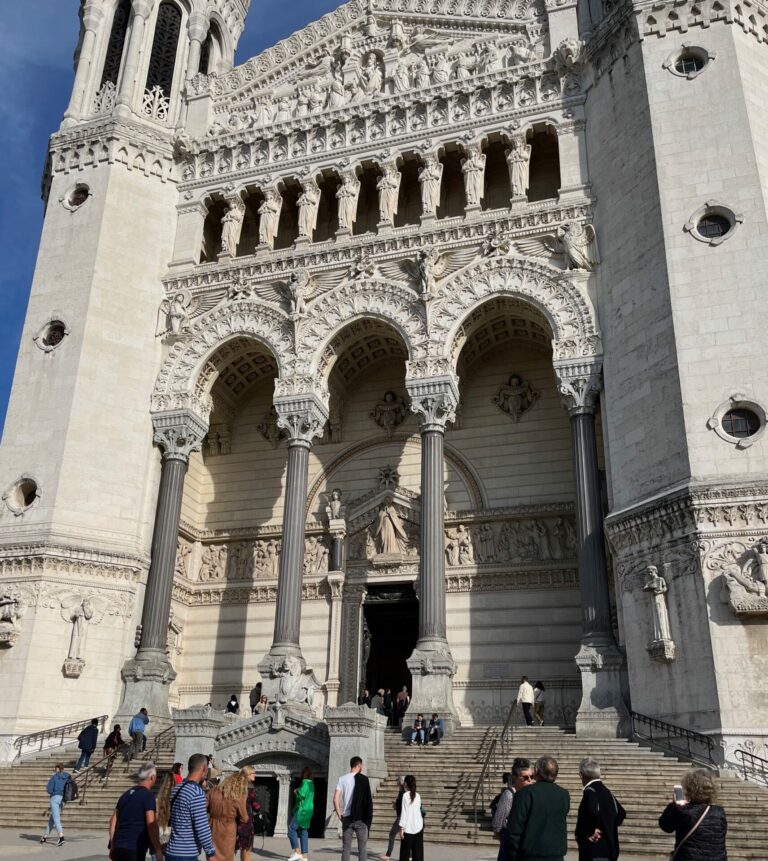
The Basilique Notre-Dame de Fourvière, the huge church high on the Fourvière hill, is a “minor basilica.” Minor basilicas are designated by the Pope as church buildings to be used for ceremonial purposes. They do not have to be a traditional church design. There are four major basilicas, all in Rome, and 1,810 minor ones, as of 2019. Many are dedicated shrines to individual saints. The Basilique Notre-Dame de Fourvière was built between 1872-96, using private funds, and is dedicated to the Virgin Mary. Designed by Pierre Bossan and Sainte-Marie Perrin, the basilica is a combination of Romanesque and Byzantine architecture, two non-Gothic styles that were “unusual choices at the time,” as one reference stated.
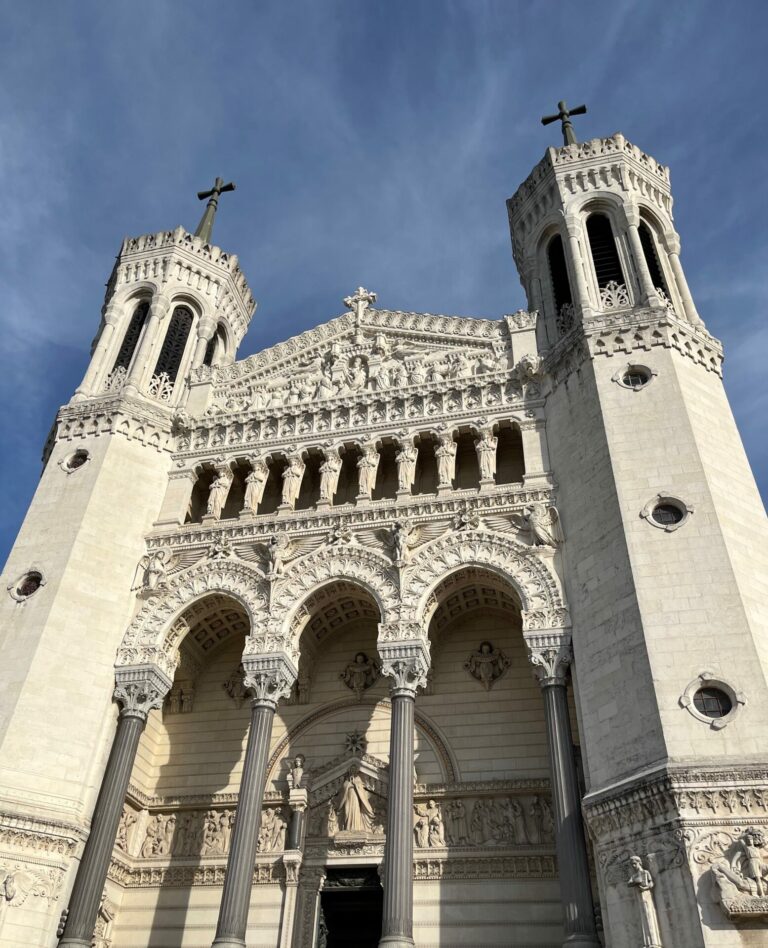
The upper portion of the basilica front. If I were a better photographer, I could manage to get the whole building in one shot. Alas …
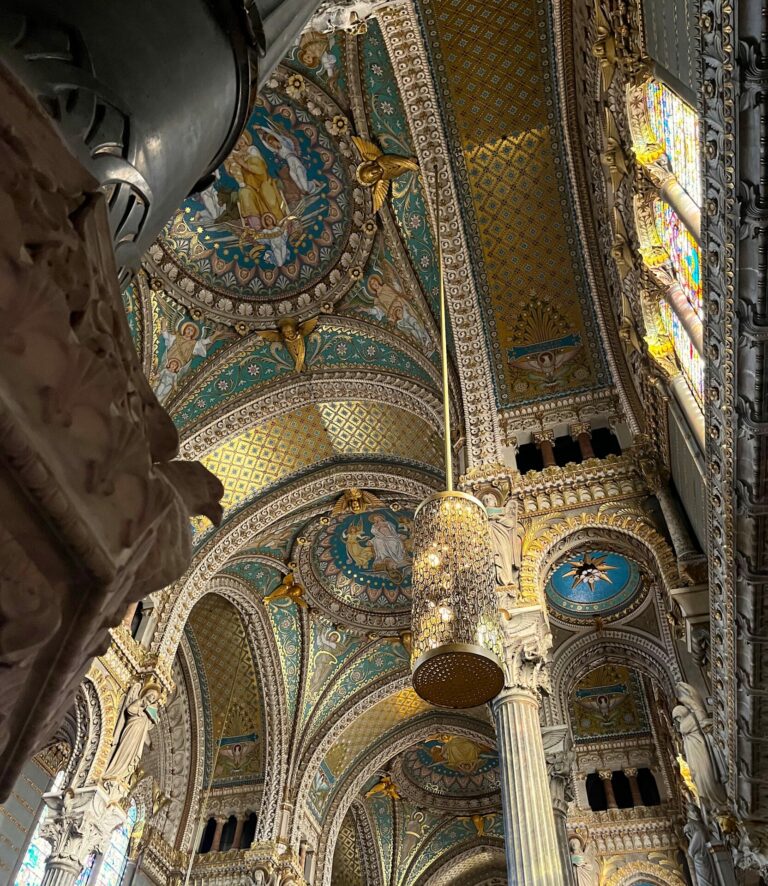
The basilica’s interior features a rather riotous assortment of decorative styles, as if the architects and designers couldn’t make up their minds which to settle on and decided instead to just use them all. Here is a portion of the ceiling featuring mosaics, paintings, and lots of gold paint.
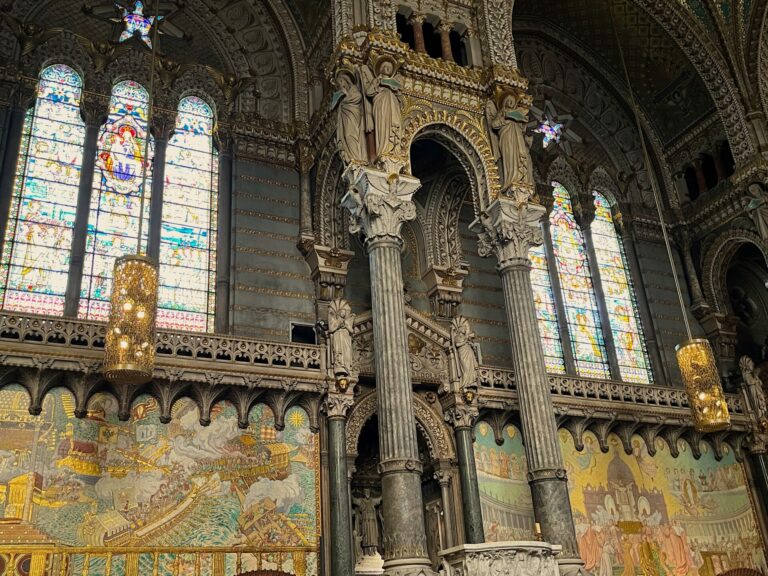
The basilica’s interior has six huge wall mosaics, dedicated to the Virgin Mary. The mosaics are some 538 square feet in size and depict various important events in French history. This website gives a good sense of the immense size of the basilica and its “decorate every square inch” approach to ornamentation — https://artsandculture.google.com/story/the-basilica-of-notre-dame-de-fourviere/9gVRAioNwv4yJw?hl=en

 War for Ukraine Day 335: A Few Odds and Ends
War for Ukraine Day 335: A Few Odds and Ends
Benw
Super cool photos and history lesson. Thanks!
So the French woke mob was tearing down statues well ahead of us Americans! Of course cheese-eating heathen foreigners invented cancel culture
ETA: also, someone fix the clock!
Amir Khalid
That’s some truly glorious architecture.
p.a.
Thanks! Wonderful stuff. As an ex-Cat’lic I always have “why didn’t they use those resources to help the poor instead” thoughts, but then you see this stuff and are humbled by the effort. It’s complicated
ETA: basic edit functions prolly can’t, but better programs can correct the optics to make tall buildings look like you used a shift lens for the photo.
Lapassionara
Amazing! Thanks
WaterGirl
MollyS sent me another photo of the ice cream confection from yesterday.
I teased her, suggesting that she was trying to preserve her reputation as someone who did NOT eat an ice cream confection that was bigger than her head. She denied it, of course, and she replied with this:
I report, you decide. :-)
WaterGirl
Wow, lovely photos!
@Benw: I presume that your comment means this post did not go up at the scheduled time?
mvr
Those are some good photos of some impressive places. It is pretty hard to convey a sense of some kinds of places in photos and I think that these cathedrals are such places. These photos do a good job. The amount of work that went in to building them is also impressive.
I also like the story of the heads!
Thanks!
delphinium
Lovely photos-those old cathedrals are always stunning.
WaterGirl
@delphinium: Oh, duh. Of course!
stinger
Nice photos of some striking buildings. Thanks also for the informative links. And don’t feel bad that you couldn’t get the entire basilica front in one shot — its own website uses an animated gif to show the mosaic walls and ceilings!
I agree with Benw, I can’t believe the cathedral hasn’t repaired that amazing clock!
The vestment looks like it incorporates metal into the fabric for hands and faces. I’d love to see that in person.
SkyBluePink
Your pictures capture the wonder and majesty of these buildings.
J R in WV
When we took the AIA tour of prehistoric art in caves of the Pyrenees we visited several churches, starting with a small church built in the 1300s. There were a ton of small sculptures uncovered by farmers plowing their fields, prechristian work brought to the church just to be safe. Not very fancy church.
Then we visited several cathedrals, one with one of the three graves of El Cid, much gold leaf and silver, since the Spanish Royals had al the silver in the known world at the time. We had the same thought, why wasn’t more of this ostentatious wealth used on education and civic purposes… because the owners of the wealth didn’t give a shit about the poor, who are always with is. Duh.
Great photos. Hard to convey the inside/outside of a huge building in still photos, good job. Thanks for sharing!
PS, that dessert is magnifique.
way2blue
Bad angels? Besides Lucifer? Who knew….
MollyS
@p.a.: My thoughts exactly on the excess in the churches … but Versailles is even worse … all that splendor for one family … tnx for the photo suggestions. I was using my iPhone, without investigating just what it can do, photo wise. Maybe next spring!
MollyS
@WaterGirl: Thanks, WG … :-) On many a Paris trip, my daughter and I start a good breakfast, then a very light lunch (often a pastry and coffee in one of the parks), ending with salad for dinner. There is so much walking involved in seeing Paris, and Lyon, that the occasional extravagant dessert is not too dangerous … not too …
MollyS
@delphinium: I’m pretty sure the responsibility for the clock lies with the cathedral and its officers. It seems to be a matter of money these days, for many such repairs.
MollyS
@way2blue: I barely remember my early years’ Catholic indoctrination but I think Lucifer has “hosts” of unnamed angels who follow him … straight to hell.